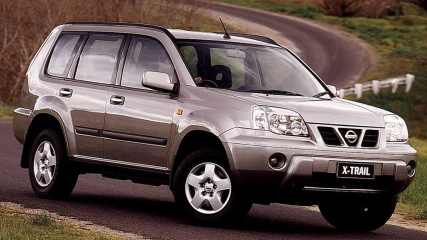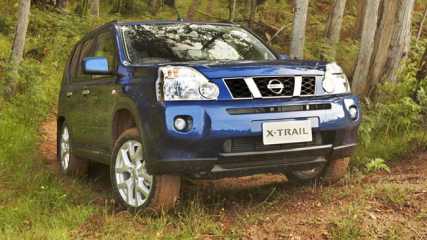Used Nissan X-Trail review: 2007-2014
By Graham Smith · 03 Nov 2017
With the X-Trail riding on a wave of popularity Nissan chose to tweak the compact SUV rather than re-invent it when it launched the new T31 model in 2007.As a result, the T31 looked very similar to the outgoing model, unless you got up close and saw the changes in detail.If you did that you would have seen it was longer, wider and taller, with more interior space, but it was also heavier.The 2.5-litre petrol engine was carried over with minor retuning, but the growing demand for diesel engines saw a turbo-diesel engine added to the range.In search of improved fuel consumption a Continuously Variable Transmission (CVT) became the automatic transmission option on the petrol engine.To meet the changing wants of SUV buyers, as more and more switched to the high-riding wagons, was the addition to the X-Trail range of a front-wheel drive model.By the time the T31 X-Trail was launched in 2007 the switch to SUVs, particularly compact models like the X-Trail, was in full swing.This new breed of buyers appreciated the practicality and versatility of a wagon, they liked the visibility of the high driving position, and while they weren’t necessarily going off road, they found the safety of all-wheel drive appealing.But they wanted more, hence the introduction of a turbo-diesel engine for better fuel economy, and a front-wheel drive model for those who had no desire at all to go off-roading.The T31 was launched with a revised model range, which was made up of ST, ST-L, and Ti with petrol engines, and the TS and TL with turbo-diesel engines.Entry to the T31 X-Trail club was through the ST, which boasted an extensive list of standard features, among them air-conditioning, a tilt-adjustable steering column, CD player and four-speaker sound, remote/keyless central locking, cruise control, variable intermittent wipers, a leather-wrapped steering wheel, power windows and mirrors, a rear wiper and washer, roof rails, a vanity mirror, cloth trim, and a trip computer. Metallic paint was optional.A step up to the ST-L added 17-inch alloy wheels, six speakers, climate control for the air-conditioning, an in-dash CD stacker, MP3 compatibility, front fog lights, and chrome exterior highlights.On top of all that, the Ti also came with power front seats, leather trim, and a sunroof.The diesel-powered TS was similarly equipped to the ST-L, the TL similar to the Ti.The spare wheel was full-sized until 2012 when a space saver spare was introduced.Bluetooth was added in 2009 allowing an iPhone or Android device to be connected.A MY10 update saw the ST-L get heated front seats and leather trim, the Ti got 18-inch alloy wheels, a DVD player, parking sensors, a reversing camera, and sat-nav.Another update in MY11 saw the release of front-wheel drive only versions of the ST and ST-L. At the same time Ti buyers were treated to automatic xenon headlamps, rain-sensing wipers, and keyless entry and drive away.The spare wheel was full-sized until 2012 when a space saver spare was introduced.There was no touch screen, or park assist system.The cabin had accommodation for five in a roomy and comfortable environment.Gone was the annoying centre-mounted speedo and other gauges that so many criticized in the T30; in its place was a more conventional dash in front of the driver.There were plenty of storage options, including the centre console, a cooled glovebox, door pockets in the front doors, and cupholders in the front and rear.The boot was a generous 633 litres with the rear seat in position, and 1651 litres when the split-fold rear seat was folded flat.The 2.5-litre four-cylinder petrol engine carried over from the earlier model, but had lower noise, vibration and harshness levels, better fuel economy, and its mid-range response was improved.With VVT variable valve timing the double overhead camshaft engine put out 125kW (167 horsepower) at its power peak, and maximum torque of 226Nm.The engine was a willing performer with solid mid-range performance, but with extra weight to haul around its zip was dulled a little compared to the T30.To meet the growing demand for diesel engines a 2.0-litre four-cylinder turbo-diesel engine was added to the range in 2008.At its peaks it produced 127kW (170 horsepower), and 336 Nm of torque, and delivered the fuel-consumption savings motorists were looking for along with the smooth drivability that comes with a good level of pulling power.Those buyers who chose the petrol engine had the choice of a six-speed manual gearbox or a CVT auto, the latter with six preset ratios to make it feel more like a conventional automatic.With a little more weight to haul around the petrol engine isn’t the zippiest performer.The turbo-diesel came with a choice of a six-speed manual gearbox or a conventional six-speed automatic transmission.Final drive was courtesy of an improved version of Nissan’s acclaimed 'All-Mode' system, which offered three modes of operation; front-wheel drive, automatic, or 4WD lock for off-road driving up to 40 km/h. Hill start and descent assistance features were added to the system.To meet the demand for a high-riding wagon from buyers not wanting to go off road in their SUVs Nissan added front-wheel drive versions of the ST and ST-L to the range in 2011.The ride is comfortable with good damping and body control on road and off.With its independent MacPherson strut front suspension and coil springs in the rear suspension, handling is balanced and assured in most situations.The steering is light and responsive, and the turning circle is tight enough to make maneuvering easy.Both engines, even the diesel, are acceptably quiet, and there’s little road noise to bother those inside.With a little more weight to haul around the petrol engine isn’t the zippiest performer, and the diesel is better with good response and drivability thanks to its torque.With a comprehensive array of safety features ANCAP rated the T31 at four stars out of a possible five.Passive safety features included front airbags for the driver and front seat passenger, side front airbags, head airbags, and seat belt pre-tensioners.It was also well equipped with active safety features, including ABS braking, BAS emergency brake assistance, EBD (Electronic Brakeforce Distribution), and ESP electronic stability control.Lap sash seat belts on all five seats facilitate the fitment of a child seat, and ISOFIX baby car seat mounting points are fitted.The earliest of the T31 X-Trails will now have done on average between 150,000 and 250,000 km, which means they need to be approached with caution and require thorough checking before being purchased.Owners report they the reliability is good and they give little trouble, but any car of the age and odometer reading of those early cars needs careful assessment of its condition.Check under the car for damage from off-road excursions. The X-Trail is quite a competent off-road performer, but its ground clearance limits it to light off-roading rather than rock climbing.Buy the car in the best condition, with the lowest odometer reading, and a complete service history.Nissan recommends servicing every 10,000km or six months. If the service book doesn’t show a car has been serviced as recommended, be skeptical.Regular oil changes, using 5W-30 oil, are the key to long and reliable engine life.Capped price servicing didn’t apply to the T31, but service costs are not excessive, and any competent mechanic can do it.Anyone opting for the CVT auto should road test a car before making their decision, as they’re a different beast to drive and you need to get used its idiosyncrasies, one being the constant whirring noise.There were some issues with the CVT in early T31 X-Trails due to a bearing that was overloaded and prone to failure, and Nissan replaced many transmissions. Listen for odd metallic noises coming from the gearbox during your road test.Another problem reported on a number of diesel models is the failure of he DPF (Diesel Particulate Filter). They’re expensive to replace if you have to.The engines use a timing chain, which means there is no requirement for regular replacement.When new, the X-Trail carried a warranty of three years/ 100,000km.MORE: If anything crops up, you’ll probably find it on our Nissan X-Trail problems.Michael Liagourdis: My 2012 Nissan X-Trail Ti 4WD auto has 93,000km on the clock and has been trouble free. It’s great cruising on the highway, and it is impressive off-road. The 2.5-litre petrol engine is both fuel-efficient and smooth. Overall it’s a fun vehicle and a pleasure to drive.Ken Collins: I have a 2012 X-Trail and I love it. I’m tall, but it’s easy to get in and out, it’s great on petrol, has a ton of power, and is great to drive, especially long distances.Ross Weldon: I have been an X-Trail owner for 13 years; the latest is a 2012 ST-L. I wanted a good highway cruiser that could go off-road when required, and the X-Trail fills the bill perfectly. It is easy to enter and exit, has one of the biggest cargo areas in their class, and the fit and finish is spot on.Rigby Gilbert: My 2008 TS diesel manual is my second X-Trail. It has now done 160,000km and is still running as well as ever. The first was a petrol model, but I find the diesel relaxing to drive when towing and the fuel consumption when towing improved.Ian & Rae Singleton: We bought our 2011 X-Trail manual because we wanted easy access in and out of the car. It’s done 43,000km, none off-road, and it has been very reliable, easy to drive and gets good fuel economy on the open road. There’s nothing glamorous about it, but it’s a good, reliable and simple SUV.Roomy, practical family wagon that’s at home on the road and off.









.jpg)
